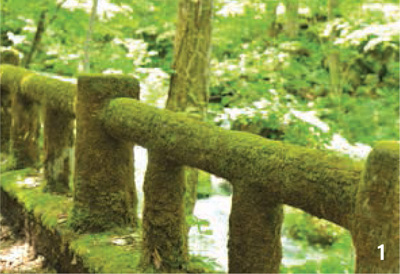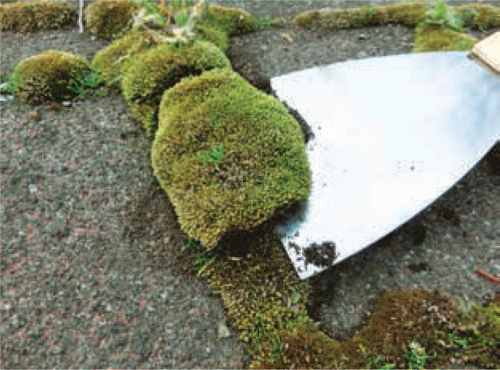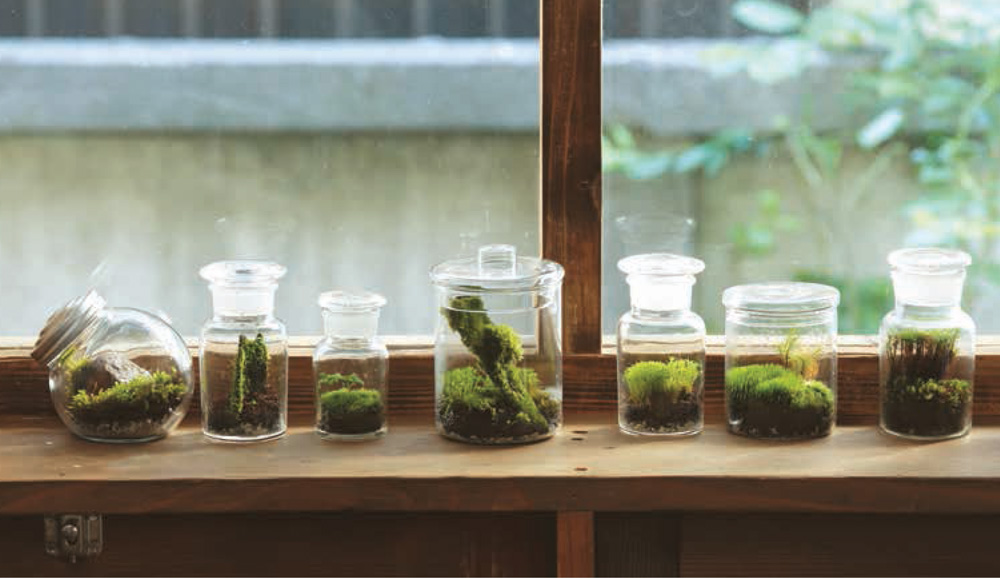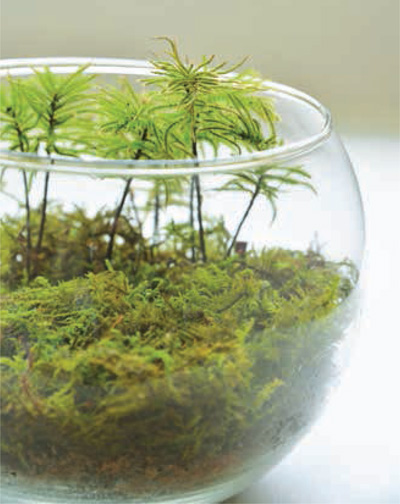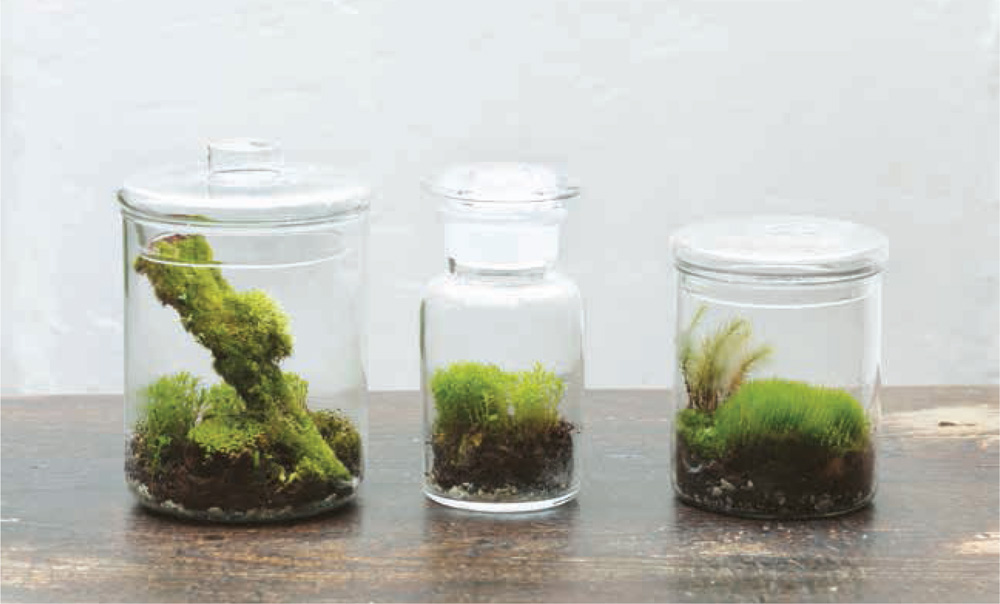Enjoying Moss
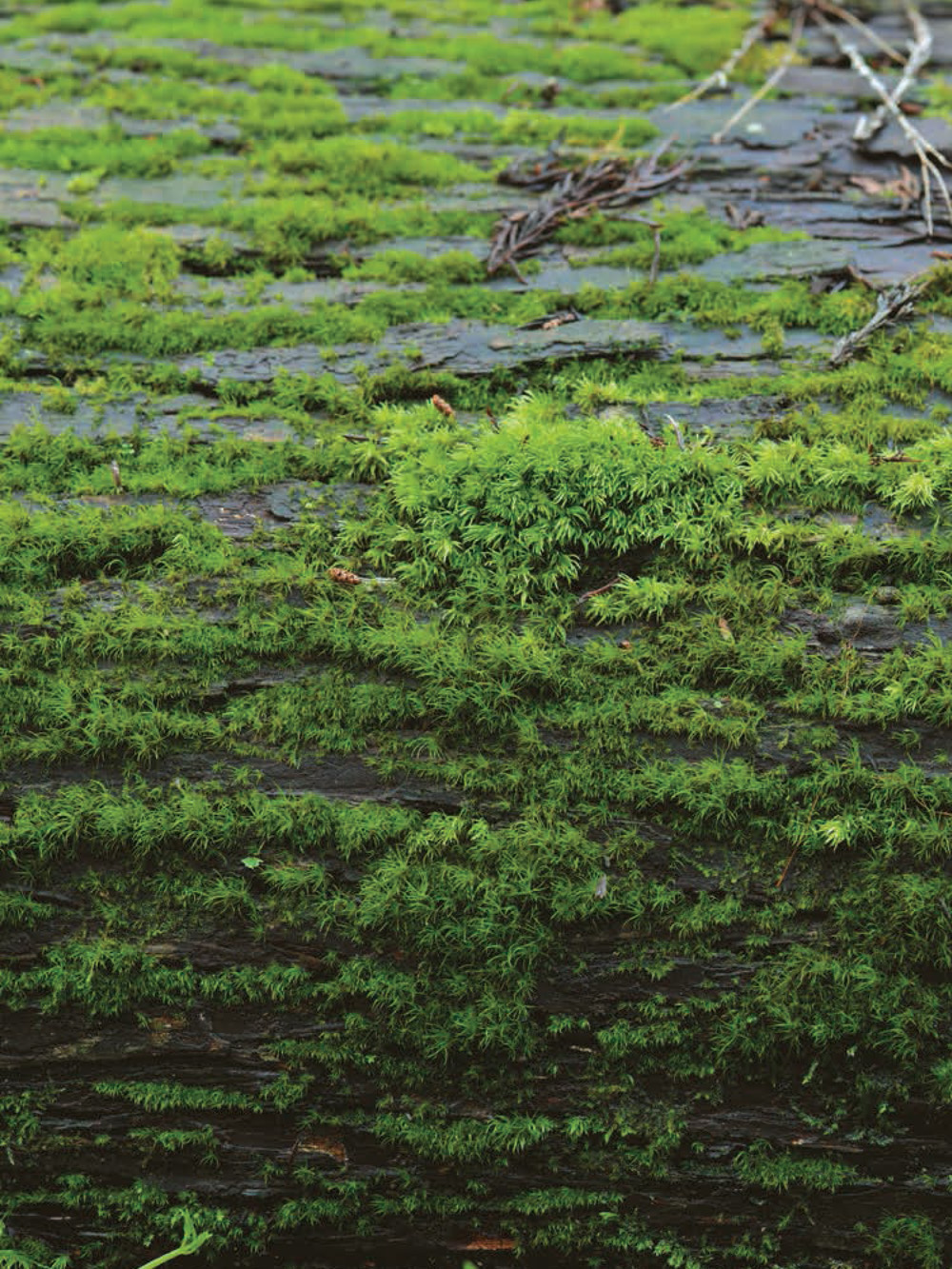
Where Can You Find Moss in Nature?


Of course you can see moss around town—in parks, peeking through cracks in concrete, and in other places. But if you’re really interested in moss, you might want to take a look at some moss-rich areas. Here are a few recommendations for you.
First of all, mountain streams in forest trails. These areas make a pleasant environment for moss: water is flowing, the humidity is just right, and sunlight is shining through in just the right amount. The shapes of the mosses here are different from the ones you see in towns. It might be easier to distinguish and identify mosses out here because they are bigger in size.
If you take a look at rocks, or piles of stones around trees, you might notice all kinds of moss and spores growing. It is kind of rare to see many types of moss in town.
With the sounds of the leaves rustling, the river flowing, birds chirping, a walk in nature is a good stress reliever. The sound and smell of moss is a part of that. There is healing power in moss.
1. Moss-covered tree bridge along the stream.

2. Moss growing by the shore.
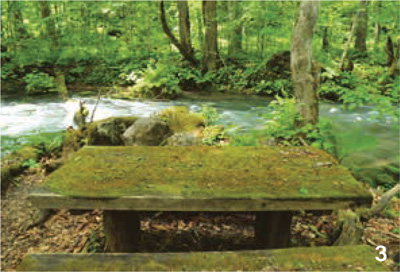
3. Stone table on the trail, being taken over by moss.
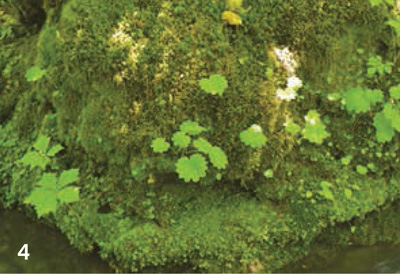
4. There are many kinds of moss growing on this big stone.
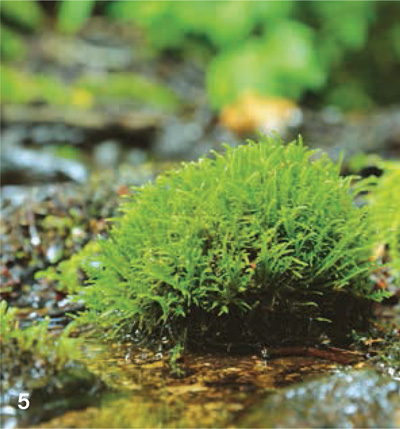
5. A moss-covered rock found in the river. It takes some time to get to this stage.
Moss Balls that Appear in Nature
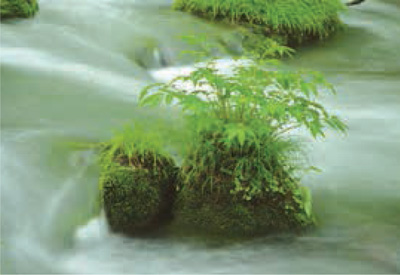
This is the Oirase Gorge in Aomori Prefecture, Japan. You can see a variety of mosses growing on the rocks in the river. This is pretty much a naturally-formed moss ball. It is thought that seeds fell on the rock and plants simply sprouted. This stream is flowing from the Towada Lake, however, even when it rains the water rarely rises, so plants are able to live on moss rocks.
We tend to assume that since moss can live as long as there’s light and water, the forest is sure to be covered in moss, but that’s not true of all the forest’s surfaces. Grasses and fallen leaves prevent sunlight from reaching the forest floor, making those areas unfriendly to moss growth. Even so, you’ll notice that on fallen trees and their stumps, moss is growing.
You can see many kinds of moss in the rocky forests created by volcanic activity. Such a spot is the Shirakoma Pond in Nagano Prefecture, known as the “Moss Forest.”★
Mt.Fuji harbors a hidden moss spot. It is registered as a World Cultural Heritage Site. There are plenty of mosses here because of the abundance of rain.
While Japan is at the forefront of interest in visiting mossy places, mosses certainly abound in other parts of the world, such as Olympic National Park in Washington (US), Banf National Park in Alberta (CA), Connemara National Park in Galway (IR) and indeed, in national forests around the world, wherever rainfall is plentiful. Wherever you go to see moss, try to view it up close.
★ Locations such as this one have been designated as “Japanese Protected Moss Forests.”
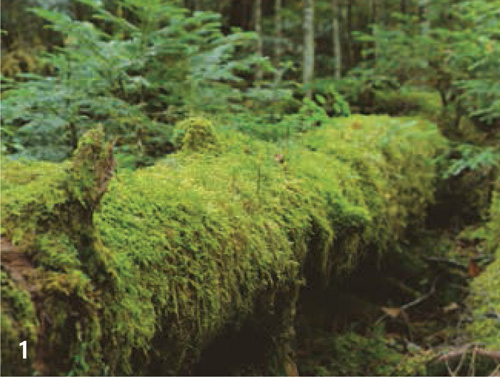
1. Moss tightly clinging to a fallen tree. Plants are growing from the mossy trunk.

2. Hinokigoke growing on slopes of cedar trails.
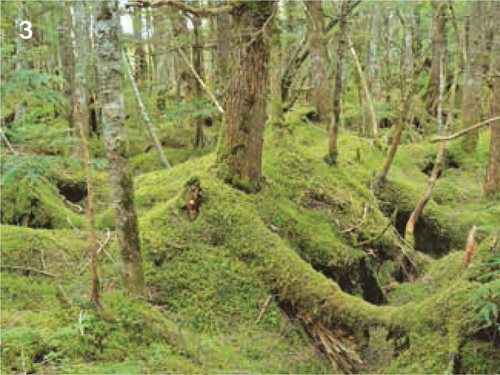
3. Mossy forest grounds around the Shikakoma Pond. These are trees growing on moss rocks.
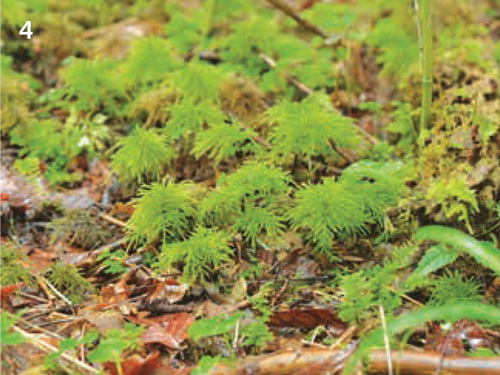
4. Fijino Mannengusa often seen around Mt. Fuji.

5. Moss growing in spots around tree trunks.
Old Developed Landscapes
Landscapes where there was human activity is perfect for moss growth. The place was developed just for growing plants, so the amount of sunlight and soil should be just right. Overgrown areas with stone walls become a favorite place for moss.
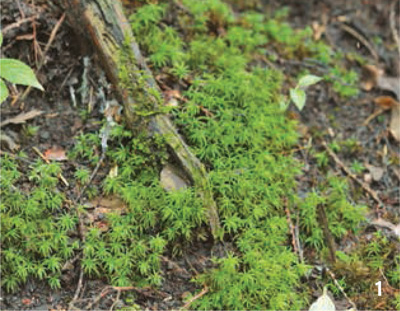
1. Moss growing on tree roots that grew by a small river.
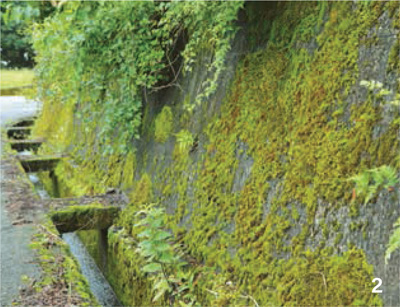
2. Moss on concrete wall.

3. Haigoke growing where sunlight hits. Where sunlight reaches it grows well, but it looks a little brown.
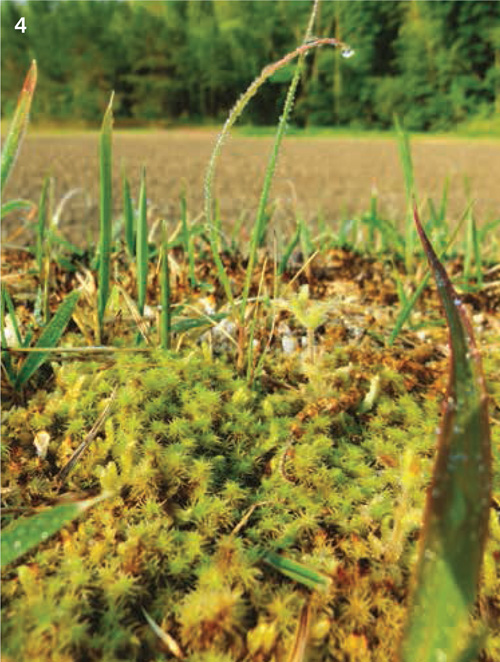
4. Sunagoke growing on sand near fields.
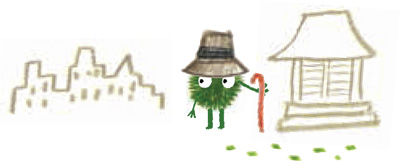
Well-kept gardens and temple landscapes intentionally emphasize moss growth. Some places are famous for their moss gardens, such as the Saihoji Temple in Kyoto, and the Hakone Museum of Art in Kanagawa Prefecture. You can generally see moss growing in shrines and temples, often in spots where rain drips down from copper roofs. It’s said that copper ions are harmless, thus the moss that grows on it (Honomjigoke) goes by the common name Tongue-leaf copper moss.
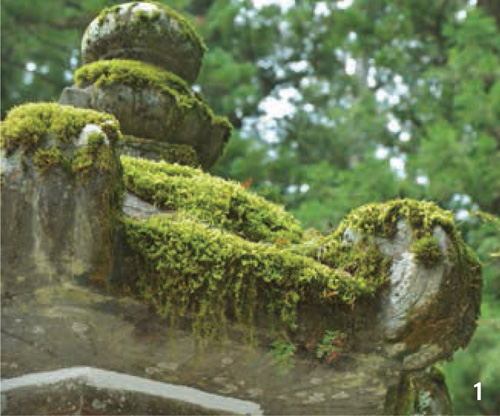
1. Moss growing on top of a stone lantern.
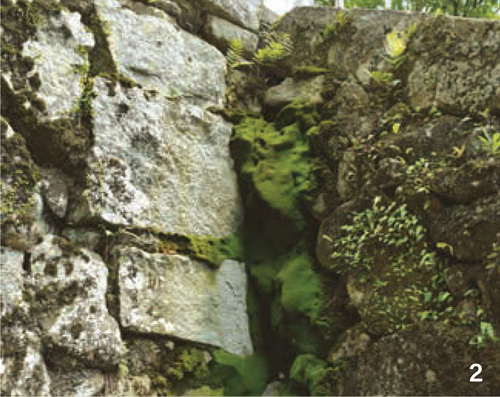
2. Moss on spots where rainwater flows from a shrine roof.
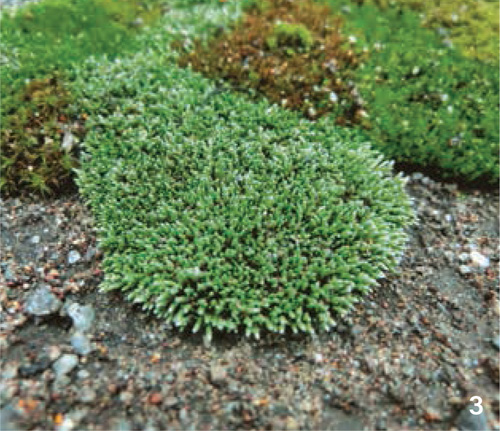
3. Silvery bryum growing on a group of rocks.
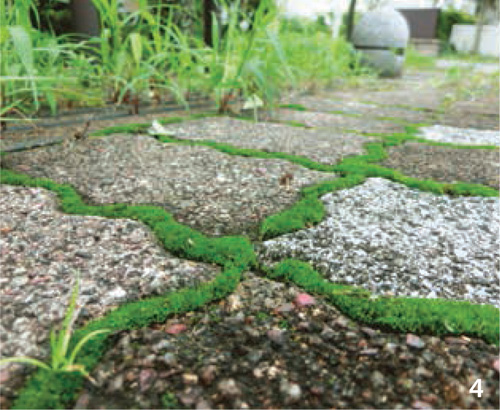
4. Hosourigoke growing between the cracks of concrete bricks.
In the City
Concrete-dominated urban areas can be a harsh environment for moss. Mosses such as Silvery bryum and Hosori are able to thrive by clumping together in small groups, allowing them to lose less moisture. Some cities deliberately cultivate moss to improve air quality.
Start out by looking with the naked eye. While it is important to learn the name, the habitat, and the shape of the moss, first just get a feel for the moss itself. Get a general sense of the atmosphere of its living space. If you’d like to touch the moss, try gently stroking it. A basic tool for observing moss in detail is the magnifying glass. Place the lens close to the moss, and your eyes fairly close to the lens. Little spray bottles are also helpful to moisten dried up moss. When you wet the moss, the leaves will open up. Also, for good note-taking, you’ll want a camera. A compact digital camera is a convenient choice. We recommend any kind that can take close-ups. A tripod is good for stability where there is low light.
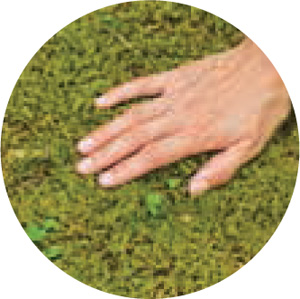
Feel free to touch the carpet-like mosses.
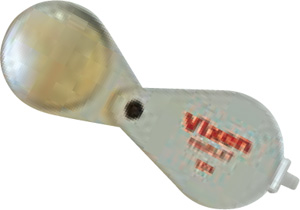
There are compact magnifying glasses you can use on the go.
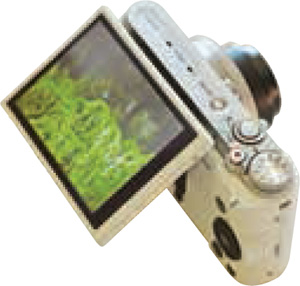
A flip screen helps when taking photos at low angles.

A little spray bottle from the dollar store—easy to carry around.

You can get a great glimpse into the world of moss by looking through a magnifying glass. Here, you can see the leaves of Sugigoke.
Collecting and Preserving Moss
You can see moss growing anywhere just outside your house. It is possible to just collect mosses near your home and play around with them.
You can use a scraper to collect colonies of moss. Remove any trash/debris that’s on its surface. Preserve it by keeping it in a bag, leaving a little opening for air, and spritzing with water when needed. Always be aware of the quantities you are collecting, as over-collecting can disrupt the ecosystem. It takes a considerable amount of time for moss to grow back, so try to take as little as possible. Be aware that there are protected areas where any kind of collection is prohibited.
You can use a scraper to collect moss from the ground or concrete cracks.
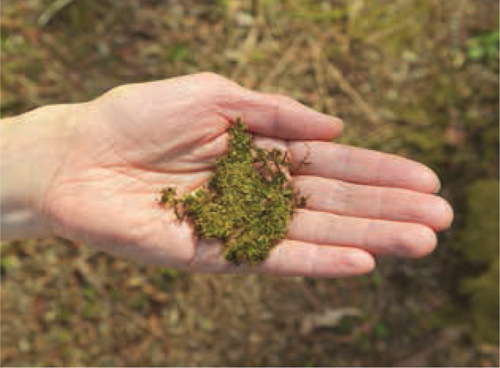
During winter, moss that’s on the ground may be pushed up and out by frost columns. This is when you can just collect by hand.
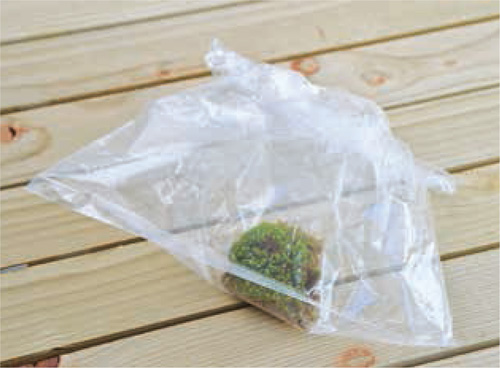
Keep moss safe in a closed plastic bag. When the moss starts to dry up, spray with some water. This way, the moss should be OK for a while. Keep away from direct sunlight.
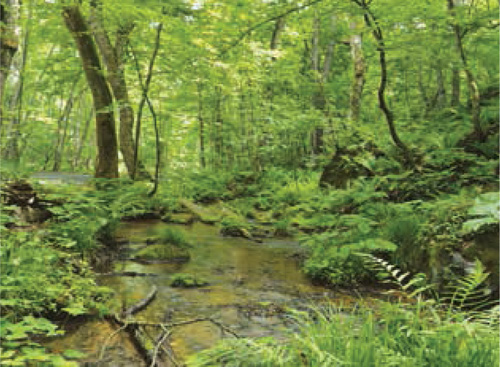
Collecting moss from protected areas is prohibited. (Check online for more information regarding your own local parks and trails.)
Terrariums
You can grow moss inside your room. The moss you’ve collected or purchased can be grown in a glass container like a terrarium. Anything from a flask to an old jar can do the job. Add to your home interior with different shapes of jars and kinds of mosses.
You can keep moss for quite a while in jars that have lids. Lids preserve moisture protect the moss from heavy air-conditioning. Jars without lids are actually easier for maintaining humidity, but it’s still important to water properly and adequately.
Goldfish bowls and vases are also great. You can use them for moss orbs or keeping long-shaped mosses.
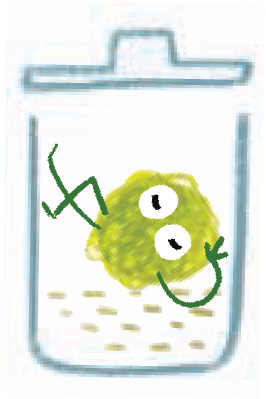
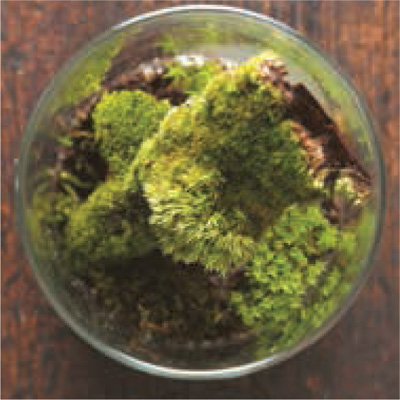
Combination of a few kinds of mosses.
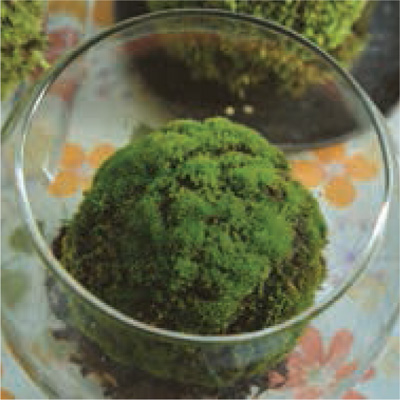
Hosourigoke moss orb in a glass bowl.
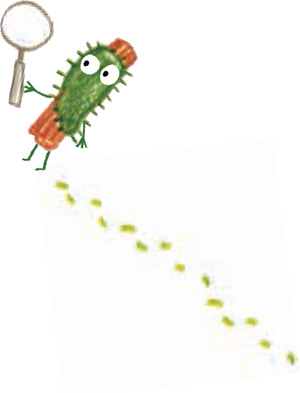
What You Need for a Terrarium
All containers should be washed thoroughly and sanitized. The bottom of the container should be layered with Fuji sand and/or fine pebbles to allow drainage thereby preventing root rot. A layer of activated charcoal can also facilitate drainage.
On top of that you can use one of the specially mixed terrarium soils, or any sanitized soil. This will be the base for the moss. Add moss onto the base, and if it seems to be falling over, just add more soil to fix it.
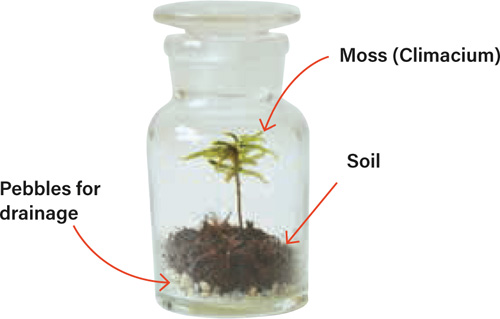
Try growing Climacium japonicum in a glass bowl. Thick layer of Fuji sand at the very bottom, then a thin layer of soil. On top of that there’s Climacium, and laid with Thuidium. Climacium loves a lot of water, so on top of just spraying water, fill about 1–1½ inches (2–3 cm) of water from the bottom.
If you are using a container with a small neck, tweezers can be helpful. When laying the moss, make sure there aren’t any gaps between the moss and the soil. Lightly spray to moisturize.
Daily Care
If you are keeping the moss in fairly narrow containers, or containers with lids, you basically don’t have to do much. Two rules:
1) Do not leave in direct sunlight.
2) Do not give too much water.
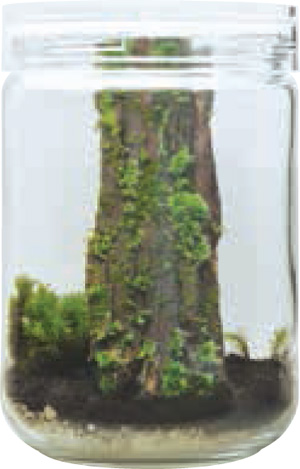
Bark collected from the cedar woods. Any debris is removed from both sides. The bottom is layered with sand and soil, and some other mosses.
Left Moss on a bark and Climacium. Center Climacium. Right Hinokigoke and Hosourigoke.
When you keep containers in direct sunlight, the internal temperature can rise to the point where it will damage the moss. But beware the other extreme: don’t keep it in a dark place. When the moss seems to be getting a little dry, spritz it, but careful to not overwater, as this will cause molding. If you think you’ve watered a little too much, leave the lid open for a while.
Bowl-shaped Containers
You can enjoy terrarium in glass bowls as well. Since it is without a lid, the care is no different from caring for moss balls. Kept outside the room, in the shade, and giving appropriate amounts of water when needed. When raising a moss orb inside a container, watering is the same as with moss balls—by soaking in water. However, if you have difficulty handing the orb, you can substitute soaking with heavy spraying.
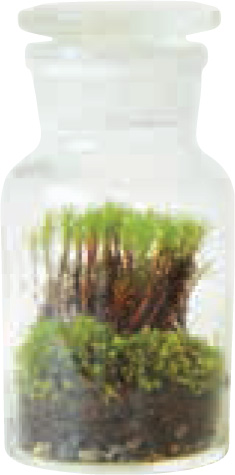
Combination of tall Sugigoke and Bryum moss.
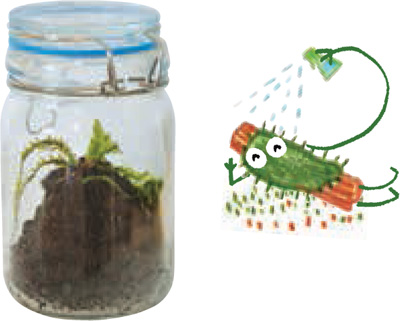
A rock is placed underneath the roots of Kotsubogoke.
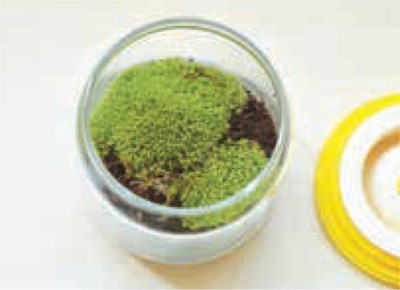
Hosobaokinagoke terrarium. If you think you’ve overwatered, remove the lid for a while to let some water evaporate.
Moss grows from spores, but many mosses can be propagated using “cuttings.” In Japan we call this process “Makigoke.” Peel the moss with your hands, cut into small pieces with scissors, then evenly spread soil in a flowerpot. You can also use a transparent container with a lid for this process. For soil use akadama or black soil mixed with river sand.
Sprinkle a little soil on top to anchor the moss against breezes. It should be left in a place that’s bright but not actually sunny. Spray to give moisture. About a month later, you might start seeing something green sprouting. However, depending on the conditions, you might not see any change even after three months. If you see no results, don’t give up, as it may just be requiring more time. Smaller moss may grow faster than the larger ones. If you notice moss growing around your home, chances are your moss should be able to grow quickly.
Makigoke in a Container
Makigoke of Hosourigoke in a clear container with a lid attached. When shutting the lid, use a piece of paper or something to keep the lid from shutting completely.
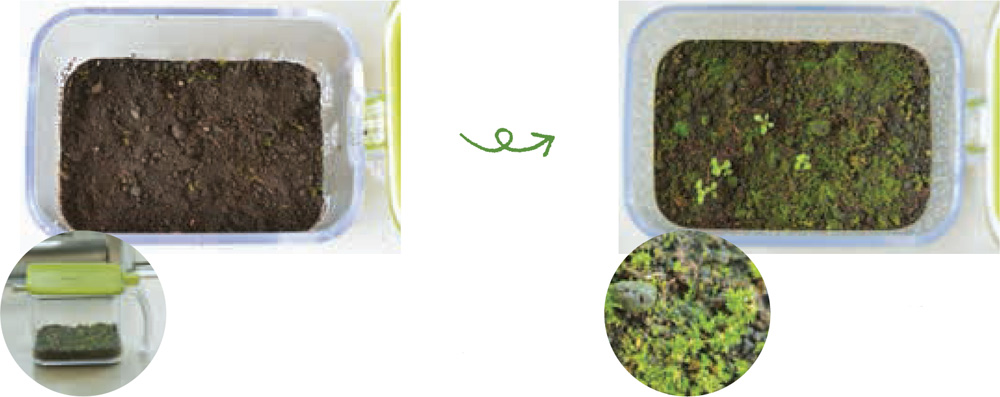
After five months. Thin layer of green on the surface. Moss growing here and there.
Makigoke in Flowerpots

Makigoke of Hosourigoke in a small pot, then seven months later. This is left outside, except when there is heavy wind or rain. After the long wait, some moss finally became visible.

This one is Silvery bryum. Tiny moss is showing after three months—it could be that it had adapted relatively quickly to its new home. Before you know it, you have new moss.
Attaching to a Tree Fern Pole
Fern and moss have similar habitats and cycles, so they make a good combination. For example, you can attach moss and fern to a Tree Fern pole (top image). Tree Fern comes in pots, poles, slabs and other shapes. This natural, woody fiber is porous and retains moisture well, and it’s easy to cling to, so climbing plants really like it. Tree Fern is available in garden shops and online.
To attach, use some twine or wires to wrap the moss and fern to the trunk. Give plenty of water and keep in the shade. After some time, the fern and moss will become one with the trunk.
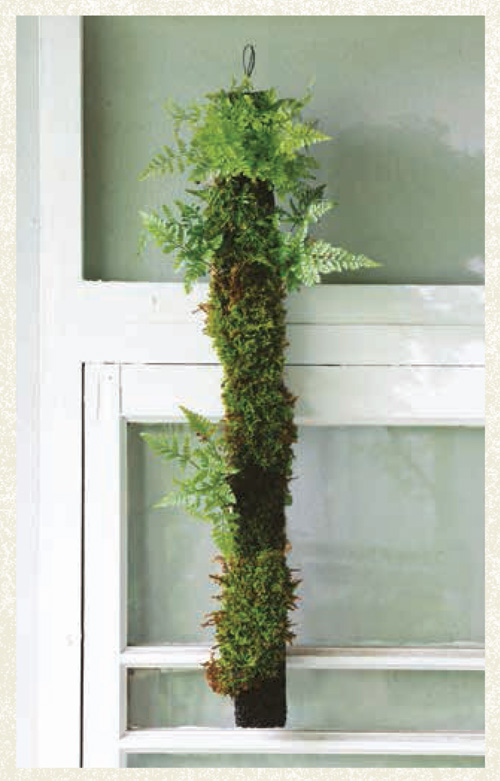
Fishing Line Moss Ball
Here, we’ve created a Shinobu moss ball with fern. Just as in creating any moss ball, we wrapped the moss around the ball of soil that holds the fern roots (refer to p. 92). You can also hang another moss ball to it (bottom right).
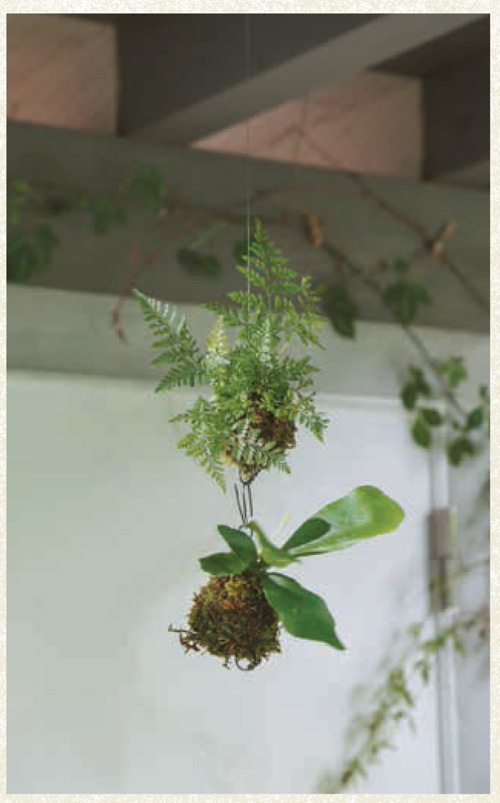
A Photo Album of Popular Mosses
Haigoke
Hypnum plumaeforme
Hypnaceae
This moss grows in colonies on straws or grass. Comparatively, it prefers brighter places. It’s often yellow-green to yellow-brown in color. Some thick branches wing out regularly. This moss is often used in Zen gardening. It curls slightly when it dries up, but does not shrink excessively.


Hosobaokinagoke
Leucobryum juniperoideum
Dicranaceae
This moss tends to grow in round clumps on low lands, mountain lands, and around the bottom of tree trunks. It has a frosty green color. It loves the shade, and even when it dries up, the leaves don’t change much. This moss is widely used in moss gardening. It could be called Arahashiragagoke or Yamagake. Arahashiragagoke is a large and leafy type.

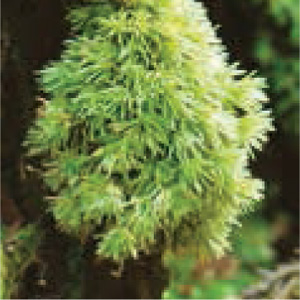
Racomitrium canescens
Grimmiaceae
Also called Hoary Fringe-moss. Grows in areas of good light, on sand or stones. It has a bright yellow-green color. The stem can grow up to 1 inch (3 cm) and contains a lot of leaves. When the moss dries up, the leaves shrink to the stem. When moisture is restored, the leaves immediately open back up. Used in moss gardening and to add greeness to buildings.
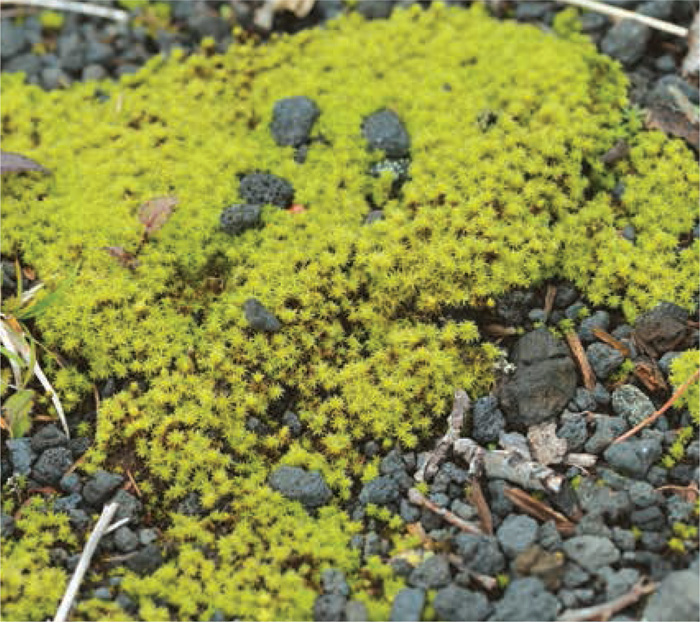
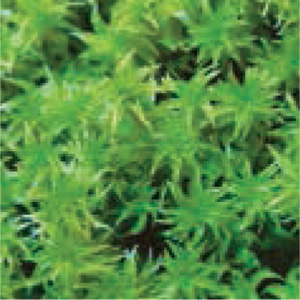
Thuidium
Thuidiaceae
Under shade, this moss grows in large groups on the ground or on stone. The stem is yellow and the branches wing out in pairs. The moss can grow large up to 8 inches (20 cm) at the stem. It has beautiful green leaves and a delicate shape. This is a great moss to use for moss balls and terrariums. (This genus includes the mosses known as Fern moss, Log moss and Mountain moss, among others).
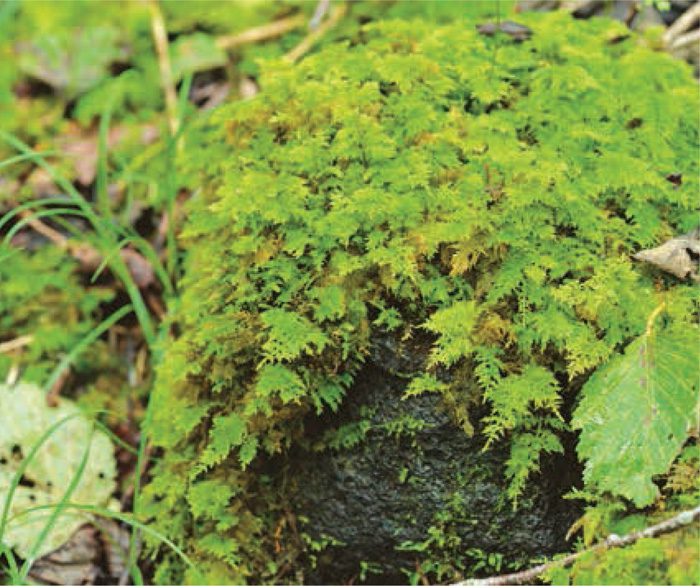
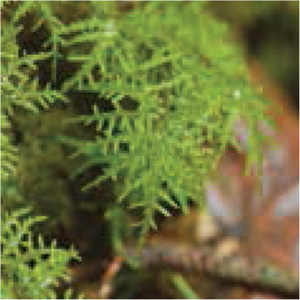
Pyrrhobryum dozyanum
Rhizogoniaceae
Also called Japanese Cypress, this is a large type of moss that grows on humus in the mountain forests. You can see this in humid and partially-shaded places, such as along a valley. It is also known as “Itachinoshippo” because of its soft bristles. Often used for gardening and terrariums.
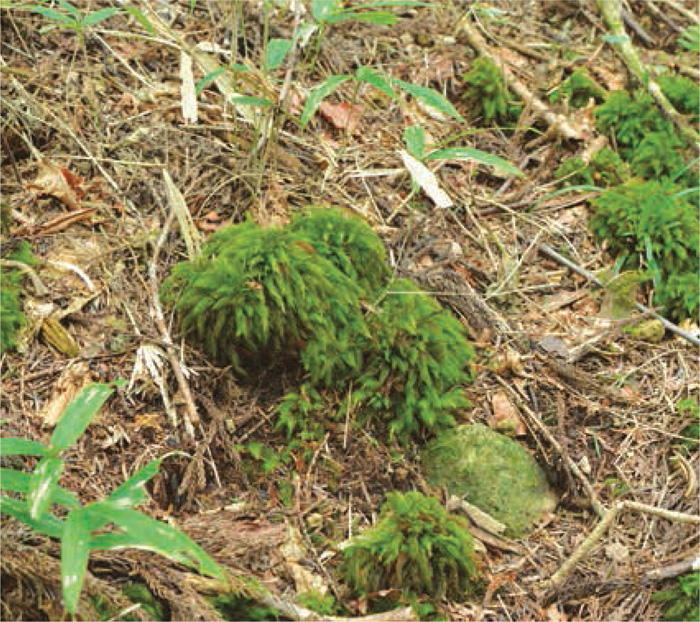
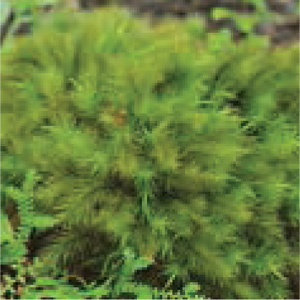
Sugigoke
Polytrichaceae
Also called Hair Cap Moss. You can see this moss from lowlands to humus on mountain grounds. It looks similar to cedar. When dried up the leaves close up to the stem. This moss has various types, some of which as are tall as 8 inches (20 cm) long and others as short as 1–1½ inches (2–3 cm) long. Often used in moss gardening.

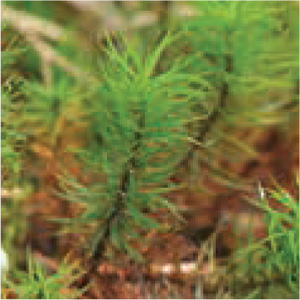
Bartramiaceae
Usually grown in lumps on wet grounds, rocks, and mountain cliffs. It prefers partially-shaded areas. The leaves are thin and sharp, and shrink when they’re dried up. You can see charming spheres sprouting during the spring.
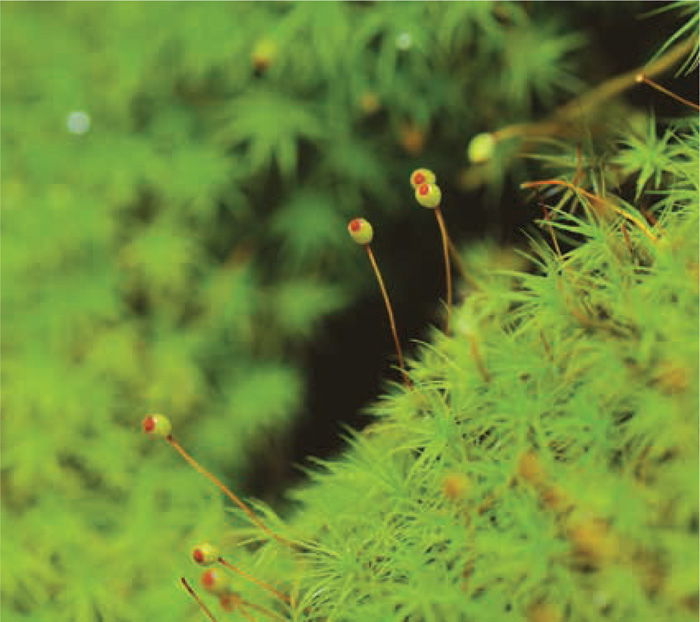
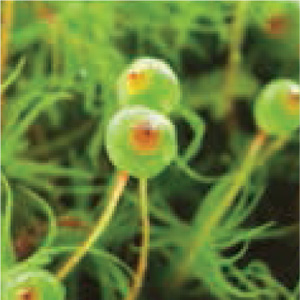
Climacium
Climaciaceae
This large moss can be found in humus in the mountain forests and can be found growing by rivers. Half of the stem is in the soil and grows many branches, rather like a tree. It is similar to other mosses such as Furousou and Fujinomannengusa. Furousou is not so tall, and grows upright. Fujinomannengusa has many small branches at the top. Often used for gardening and terrariums.
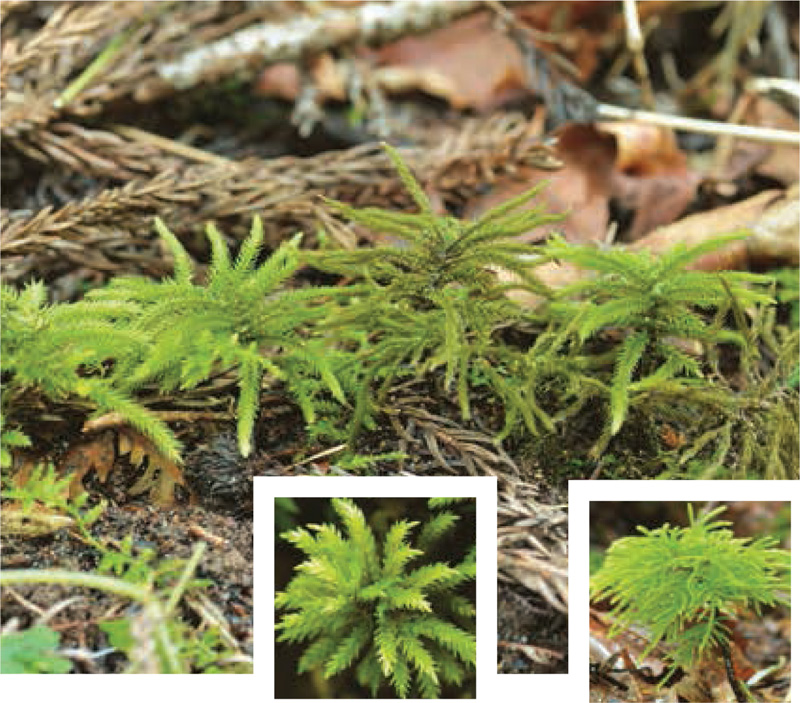
Plagiomnium acutum
Mniaceae
From residential areas to foohills, in the shaded areas you’ll see this moss growing on the ground or stones. It can grow both upright and outward. The egg-shaped leaves grow out in two rows. The rhizoid comes out to help new stems grow.

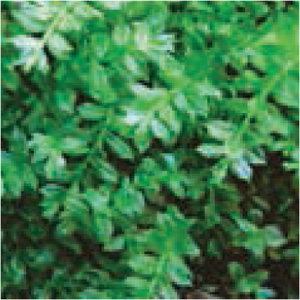
Mizugoke
Sphagnum moss
Sphagnaceae
This moss can be seen growing on humus and in wetlands. It is often used in gardening to insulate and help the soil retain moisture, and has uses outside of gardening as well.

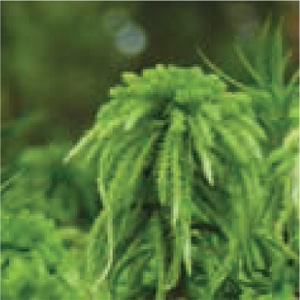
Bryaceae
This moss is quite popular. It can be seen in many places, bright shade to shaded areas, in gardens or concreted areas. It is relatively persistent to dryness. The tips of the leaves have a grayish-white color. Often used in bonsai and moss gardening.
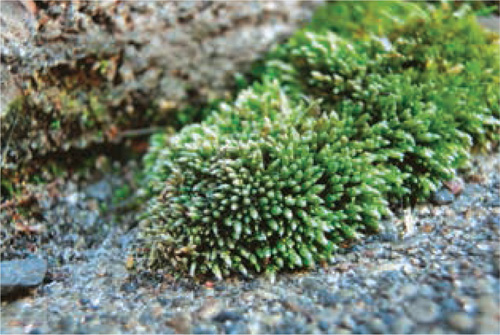
Hosourigoke
Brachymenium exile (Dozy et Molk.)
Bryaceae
You can see this bluish moss growing in colonies between the cracks of concrete and stone steps. Sometimes this moss is grown with silvery bryum, as its look is similar. When given moisture, the leaves open up.
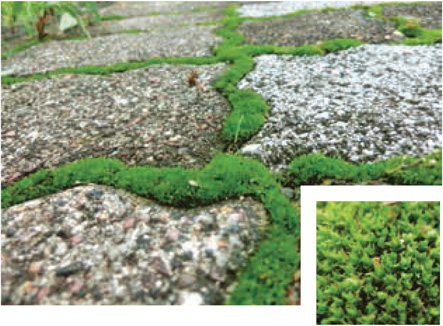
Hyophila Moss
Pottiaceae
You can often see this moss in sunny places and under the shade, growing on concrete walls and stone surfaces. It has a green to brown color. It has a radial growing pattern, so the leaves curl up in a spiral.
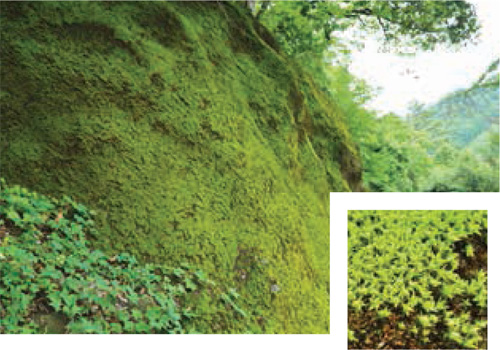
Honmonjigoke
Scopelophila cataractae
Pottiaceae
Also called Tongue-leaf Copper Moss. The name of this moss derived from the Ikegami Honmon-ji Temple in Tokyo, which is where it was first discovered in Japan. It is often found in places where rainwater falls or flows through, such as on top of copper roofs. It is found more in urban areas than in the mountains.
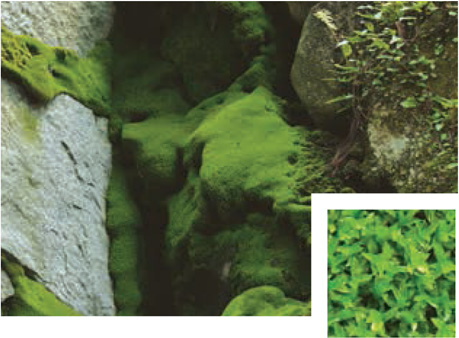
Brachytheciaceae
This moss often grows in shaded areas at a tree’s roots or on the ground surrounding them. It isn’t unusual to find this in urban areas. The stems crawl to the side and eventually form a carpet.
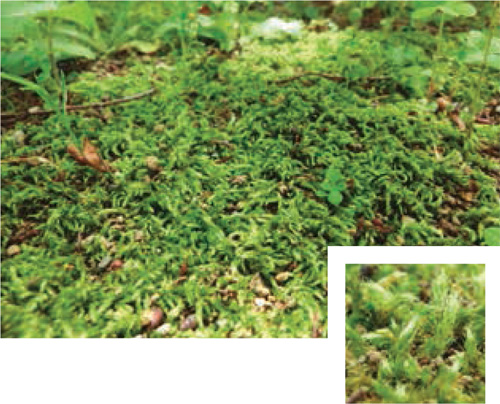
Shippogoke
Dicranium howellii
Dicranaceae
This moss grows in colonies, on top of humus in the forest or at tree roots. When dried up, the leaves tend to bend in the same direction. There are about 20 species in Japan.
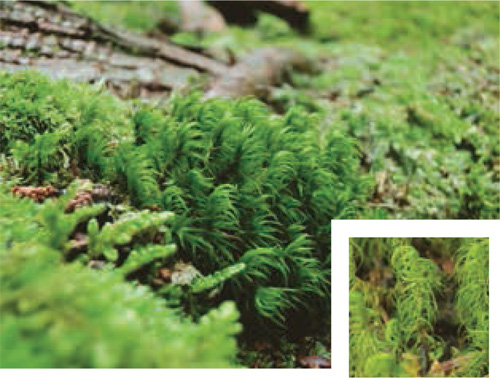
Bryum Moss
Bryaceae
In shaded areas, this moss is usually seen on concrete, flowerpots, tree trunks or rocks. Usually found in towns. When dried up, the leaves will curl up in a spiral. There are about 25 species of Bryum moss in Japan.
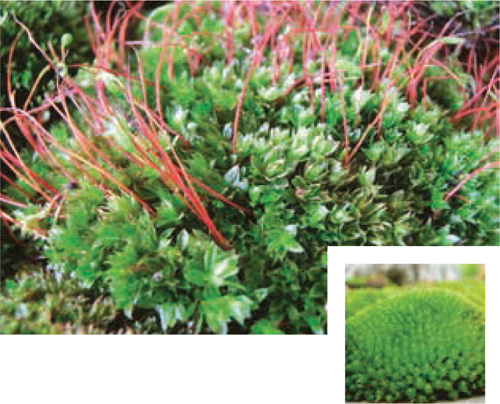
Tachigoke
Atrichum undulatum
Polytrichaceae
Also called Common Smoothcap moss In shaded areas from lowland to mountains, this moss grows on wet soil or stones. It seems to be softer than Sugigoke, and the leaves are about ¼ inch (7–8 mm) long. The leaves shrink when dried up. This moss is also often used in gardening.
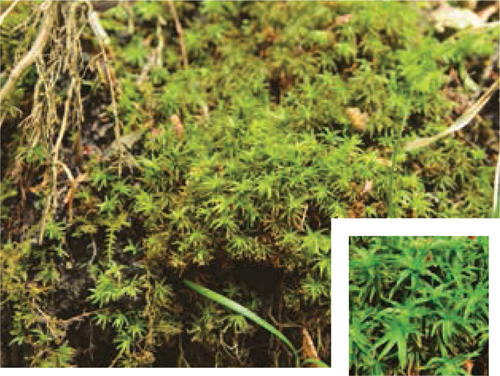
Hylocomium splendens (Hedw.) Schimp.
Hylocomiaceae
This moss is found in the shaded areas in the forests. They grow in large colonies on humid soils, such as humus or on rocks. The new stem grows upward from the middle of the previous stem, which creates stair steps. Long ones may grow over 8 inches (20 cm).

Houougoke
Fissidens dubius
Fissidens
This moss lives on partially-shaded grounds or on wet rocks near the mountain stream. The pairs of leaves grow thick. It takes its name from its appearance of the leaves, which resemple the tail of a cocoon. About 42 different kinds of this moss can be found in Japan.
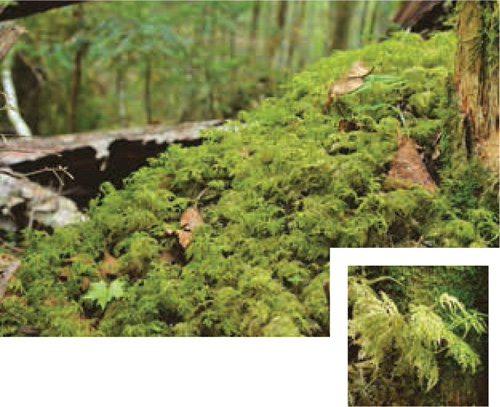
Goblin’s Gold Moss
Schistostega pennata
Schistostegaceae
Also called Dragon’s Gold. This moss grows in dim and damp places such as in mountain caves, or gaps between rocks. The stem is about ¼ inch (7–8 mm) long, and the leaves grow in two rows, one on each side of the stem. It’s not the leaves or stems that cause the moss to glow. Cells of the “protomata” germinate from spores, and before they take plant form, their spherical cells act as lenses that absorb and reflect light. The glow can been seen in very dim light only.
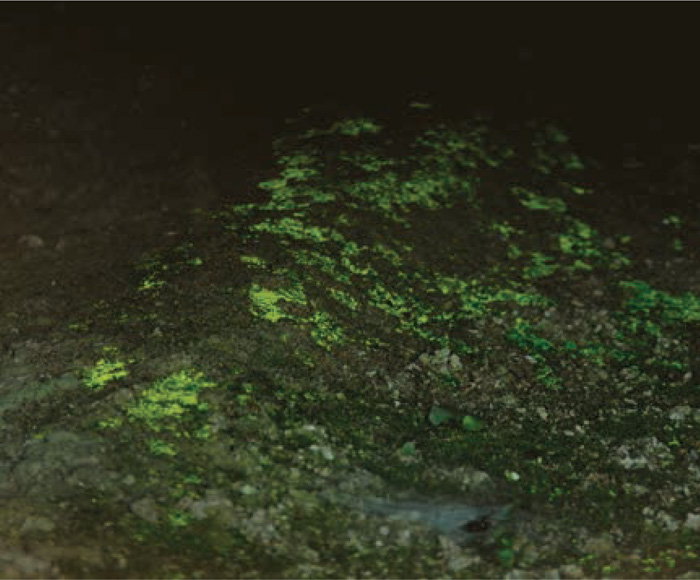
How to Preserve Moisture
Unlike most other plants, moss has no real roots to absorb water or nutrients. The only thing supporting the body is the rhizoid. Moss absorbs water from the leaves and stems. Without moisture, photosynthesis stops, preventing growth. Therefore, mosses gather in a colony, forming in ways that help preserve moisture.
Surviving Dehydration
Even if the moss dries up, it doesn’t immediately die out. For most kinds of moss, once they receive moisture they usually revive. The leaves just shrink or curl up when they are thirsty, waiting to come back to life.
There Are Several Ways to Multiply
Moss generally propagates via spores. After fertilization, the spore body extends upwards, and the tip is covered with spore-packed pods. Spores are released from these pods and are airborne. There are also other, more successful ways of propagating. For example, moss can multiply asexually. Loose or broken pieces of moss can travel by air and establish new growth where they land, if the conditions are right. Moss can also form new plants from broken stems and leaves. Some mosses are easy to separate, some stick to the back of animals, or shoes, and go on a journey to breed.
Why Isn’t It Being Eaten? Does It Taste Bad?
Compared to other plants, mosses are rarely eaten by animals or insects. That might be because the moss looks unappetizing, a natural defense mechanism. In addition, they are said to have antibacterial properties that protect them from rotting easily or growing mold.
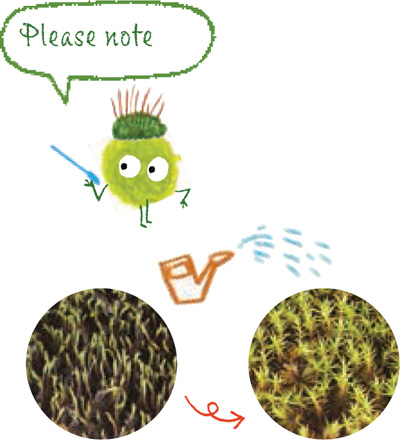
Dried up Sugigoke, and watered Sugigoke.
Composition of Moss
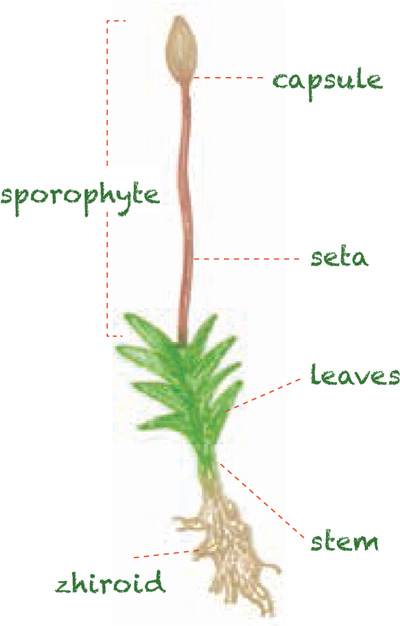
Mosses, Liverworts and Hornworts
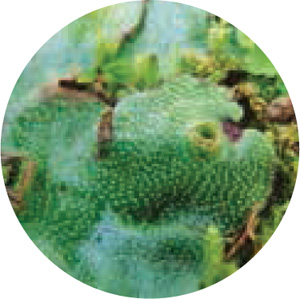
Zenigoke can often be spotted in the shaded areas of the garden.
Generally, the plant type commonly referred to as “moss” are actually Bryophytes, of which moss is simply one type. The leaves of mosses are simple and their texture is generally velvety. Within this group there are upright types such as the the Sugigoke (Common Haircap moss), and creeping types such as the Haigoke. Most bryophytes used in gardening are mosses. Liverworts’ leaves are lobed in shape. The Zenigoke is an example of a liverwort. Horn-worts are similar to liverworts, but their leaves are more irregular in shape. There are far fewer known species of hornworts than of mosses or liverworts.
